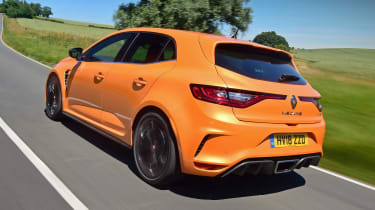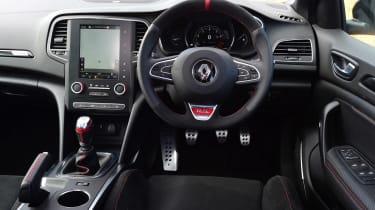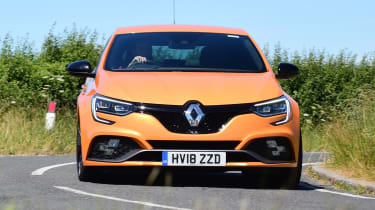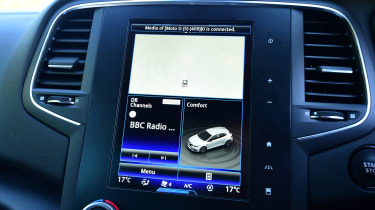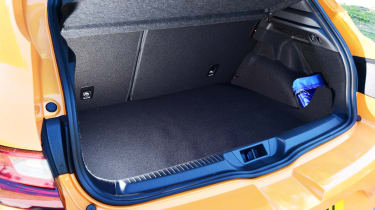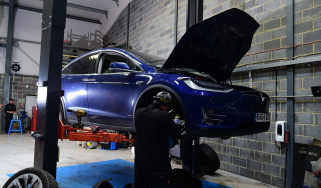Renault Megane RS review
The Renault Megane RS is a sophisticated hot hatch that's a true contender in the class

The standard Renault Megane has been for sale since 2015, but we had to wait a little longer for the Renaultsport (RS) model. However, when it finally arrived in 2018, it turned out to be well worth the wait. While the three-door coupe body has been replaced by a five-door hatchback, the Megane RS has the same mix of ingredients to make it a hot hatch front-runner.
That's good, because it needed to be at the top of its game to take on a slew of rivals that deliver driving thrills. The new Megane RS 280 joins the hot hatch establishment which includes the VW Golf GTI and Honda Civic Type R, both of which are strong rivals for the Renault. But there are also leftfield choices, such as the Hyundai i30 N, Skoda Octavia vRS, SEAT Leon Cupra and Peugeot 308 GTi – all cars with their own particular strengths.
• Renault Megane R.S. vs Honda Civic Type R vs Hyundai i30 N
But what's probably more important is that the Renaultsport Megane needs to be better than the car it replaces, as past Renaultsport models have gained a cult following for their track-focused handling. To do this, Renault has swapped to a smaller yet more powerful 276bhp 1.8-litre turbocharged engine (which is shared with the Alpine A110) and there's the option of a six-speed manual or six-speed twin-clutch auto to put power to the front wheels.
Used - available now

2020 Hyundai
i10
39,012 milesManualPetrol1.0L
Cash £6,750
2020 Volkswagen
Polo
21,561 milesManualPetrol1.0L
Cash £13,449
2023 Mercedes
A-Class
26,452 milesAutomaticPetrol1.3L
Cash £20,599
2022 Ford
Focus
17,016 milesManualDiesel1.5L
Cash £14,597Adaptive dampers are fitted as standard, so unlike the last Megane RS you can dial out the stiff ride and make this Renaultsport model as comfortable as the standard Megane. Another addition is four-wheel steering, making the Megane RS the only current hot hatch to come with rear wheels that steer. It's designed to increase agility at low speeds and stability when driving fast, and we're happy to report that it does help the Megane RS to deliver a fun drive, even though the system adds a bit of weight to the car.
As before, there are standard and Cup versions of the Renaultsport Megane, with the latter adding stiffer dampers and a limited-slip diff to boost traction out of corners. There's also the Renaultsport Megane 300 Trophy, and as the name suggests, it gets more power than the standard car (297bhp), thanks to a revised turbo and exhaust system, plus bigger brakes, slightly different looks and sticky tyres designed for track use. However, while past Trophy models have delivered an even more thrilling drive, the current version isn't quite as focused as its predecessors.
In 2019 Renault added the Megane RS Trophy-R to the range – a lightened, more focused version with trick suspension upgrades and improved aerodynamics. The limited-run car features an Akrapovic titanium exhaust amongst its upgrades, along with optional carbon fibre wheels and carbon-ceramic brakes. The end result is a spectacular hot hatch, but one with prices that start at over £50,000 – or over £60,000 after options.
Prices for the rest of the Renaultsport Megane range start from around £28,000, with the Cup model around £1,400 extra and the Trophy starting from just under £32,000.
Developing a first class hot hatch is arguably one of the hardest tasks in the car industry; not only does the car have to be a riot to drive and look special, it needs to comfortably carry a family and their luggage too. The Renault Megane R.S. hits that brief, if perhaps not quite nailing it as well as some rivals. It’s utterly composed at speed and incredibly nimble, but it feels like a car that has more to give; it lacks that last degree of aggression and engagement that the Honda Civic Type R delivers. The hardcore Trophy-R model irons out the majority of our issues with the standard car but its race-inspired upgrades make it far too expensive for most.
Engines, performance and drive
In Comfort or Normal mode you’d be hard pressed to tell the difference between a standard Renault Megane and the Renaultsport version in terms of refinement. The hot hatch is quiet, smooth and incredibly compliant, even over rutted surfaces.
As the road tightens and becomes faster, toggling through Sport and Race modes sees everything become a little more aggressive. The engine note is synthetically enhanced by the cabin’s speakers, which sounds sub-optimal but is executed well and proves convincing, while crackles and bangs erupt from the exhaust when shifting down through the gears. For a four-cylinder turbo the Renault Megane RS sounds fantastic.
The six-speed dual-clutch auto reacts immediately to your every command; the box is able to jump gears on the way down through the ratios if you pull and hold the left paddle in Sport or Race mode. It’s a shame the paddles don’t operate with a satisfying thud; instead the action feels a bit soft and mushy.
The steering isn’t brimming with feel but is accurate and combined with the Megane’s four-wheel steering means this hot hatch has gymnast levels of agility. Below 62mph in Race mode the rear wheels turn in the opposite direction of the fronts to boost precision on the entry to corners; you can feel the rear end begin to swing round and the nose tuck tighter into a bend as you apply more lock.
Initially you find yourself recalibrating the amount of steering angle you need to apply because the Megane RS turns in so quickly it almost catches you off guard. Then, when you get on the throttle, because the Sport chassis only gets torque vectoring rather than a proper mechanical limited slip differential, you can feel the car begin to scrabble away at the tarmac, hunting for grip. It’s a sign you’re being over enthusiastic with the right pedal.
Where the hot Megane really excels is its ability to cover bumpy and rutted ground at speed with real composure. The hydraulic compression stops fitted to all shock absorbers are the kind you’ll find on rally cars; it means the RS is able to absorb big compressions and road undulations without any fuss. The superb body control gives you huge confidence to hustle the car over poor roads at higher speeds.
Like before there are two chassis setups available on the Renault Megane RS - Sport and Cup. You can spec either with a manual or automatic gearbox. The Sport chassis is the standard setup and kits the RS out with redesigned hydraulic compression stop shock absorbers and torque vectoring on the front axle to tame understeer. Opt for the Cup chassis, which will set you back around £1,400, and Renault throws in a mechanical limited-slip differential and 10 per cent stiffer dampers.
Go for the Renaultsport Megane 300 Trophy, and the differences in performance between it and the standard Cup model are hard to pinpoint – you really need to drive them back-to-back to feel the differences. That's because the standard car's set-up is already pretty sharp, and this Trophy model doesn't feel as hardcore as previous Trophy models.
The limited-run Trophy-R is the best of the bunch. The car smashed a number of front-wheel drive production car track records and it's easy to see why – grip is immense, the reworked (and adjustable) suspension is impressive and lack of rear-wheel steering all help make it a remarkable car to drive quickly.
The Trophy-R weighs 130kg less than the Trophy on which it's based, thanks in part to a carbon fibre bonnet and diffuser, Akrapovic titanium exhaust and Sabelt bucket seats. The rear seats are ditched completely in Renault Sport's quest for performance. Optional carbon fibre wheels save four kilogrammes per corner but are an eye-watering £12,000 option.
All of the Trophy-R's upgrades combine to make it the best option for die-hard hot-hatch enthusiasts. It's very expensive, but few hot hatches that can deliver the same depth of performance and feedback.
Engines
The Megane RS uses a 1.8-litre turbocharged 4-cylinder engine that generates its 276bhp at 6,000rpm. Maximum torque of 390Nm is delivered to the front wheels at 4,800rpm, and that’s enough to get the car from 0-62mph in 5.8s before it advances on to a 158mph top speed.
The more powerful 300 Trophy adds a new turbo with ceramic ball bearings that boost its responses, plus a freeer-flowing exhaust with a mechanical valve that boosts gas flow even further. This bumps power up to 296bhp, while torque is up to 400Nm in the manual model, and 410Nm in twin-clutch cars. 0-62mph is a tenth quicker at 5.7 seconds, but it's the engine's mid-range pulling power that really impresses, especially as it's accompanied by a more aggressive exhaust note. Neither turbocharged engine has any discernible lag, either.
The Trophy's engine is retained in the go-faster Trophy-R, but performance is increased thanks to the latter's lighter kerbweight and racier tyres. 0-62mph takes 5.4 seconds and top speed is 163mph.
MPG, CO2 and Running Costs
The Megane RS is one of the less expensive hot hatches on the market to buy and run, with list prices starting from around £28,000. In comparison, the Hyundai i30 N is roughly the same price, the Peugeot 308 GTi is around £1,500 more and the VW Golf GTI and Honda Civic Type R are both over £30k.
The French firm says the Megane’s 1.8-litre engine will return 34mpg on average when combined with the dual-clutch gearbox or 35.8mpg with a manual. However, on test we have recorded a figure just below 30mpg – which still isn’t bad for a 279bhp performance car. If you drive up to 12,000 miles per year it equates to around £2,377 per year in fuel alone.
The more powerful Megane RS Trophy sees slightly reduced economy – 34.4mpg with a manual gearbox or 33.6mpg with the dual-clutch gearbox.
Emissions for the standard car with a manual gearbox stand at 181g/km of CO2, dipping to 171g/km for the dual-clutch auto. The Trophy emits 183g/km and 176g/km with an auto and manual respectively. The limited-run Trophy-R, meanwhile, returns 35.8mpg and emits 180g/km of CO2, its marginally improved figures attributable to its stripped-down weight.
After April 2019, annual road tax will cost £145 per year (after the CO2-weighted first-year payment) as the Megane dips well below the £40,000 road tax supplement threshold (except in the case of the Trophy-R). All models sit in the highest-possible band for company car tax, with a 37% BiK charge.
Insurance groups
As the Megane RS uses a smaller engine and is less powerful than some of its rivals, it sits in insurance group 35, which is between the Civic Type R in group 40 and the Golf GTI in group 33.
Depreciation
Over a three-year period and 36,000 miles the Megane RS is expected to retain 41.4 per cent of its value, according to our experts. That means a model with the Cup chassis will be worth around £12,000 when it comes to second hand value. It loses £16,994 of its value over that period.
Interior, design and technology
Visually, the Renaultsport Megane RS cuts a striking shape on the road; it’s squat stance emphasised by bulging arches housing beautiful 19-inch alloy wheels. In our eyes it sits squarely between the Golf GTI and Civic Type R in terms of aesthetics, striking a perfect balance between aggression and subtlety.
The cabin is a similar story; there are enough sporty Renaultsport flourishes, such as the Alcantara steering wheel and deep bucket seats, to give it a sense of occasion. Of course it’s not perfect, the fake carbon fibre effect fabric on the doors look like an aftermarket part and some of plastics on the dash and centre console feel rather cheap.
Sat-nav, stereo and infotainment
The infotainment system – plucked from the standard Megane – still isn’t the easiest to navigate and the lack of haptic feedback from the screen often leaves you wondering if you selected the correct function. There are also a lot of menus and sub-menus, meaning it’s easy to get lost in the system if you’re trying to use it while driving.
Practicality, comfort and boot space
The Megane RS is only available as a five-door model, and the transition from standard hatchback to hot hatch hasn’t robbed the car of any of its practicality. So if you’re a keen driver with a family to transport around, the Renault Megane RS isn’t really much less suitable than a standard Megane model.
Legroom, headroom
Like the standard Megane, space inside is pretty good. There’s decent headroom for those in the back, but the deep buckets seats steal a fair bit of knee room and space in the foot well. So although you have the ability to sit three people across the back bench (unlike in the Honda Civic Type R, which only has two rear seats) you probably wouldn’t want to spend too much time back there.
Boot
The boot is unchanged from that of the standard hatchback at 384 litres, which is more than you’ll find in a Golf GTI. If you drop the rear bench the amount of space available increases to 1,247 litres.
Reliability and Safety
A raft of safety kit such as cruise control, blind spot monitoring and lane keeping assist ensure the Renaultsport Megane RS will be safe on the road. The addition of grippier tyres and bigger brakes boost the Trophy's safety credentials, although those sticky tyres might not be quite so effective when it's wet.
Either way, the Megane RS is based on the standard Megane, so it shares the same five-star Euro NCAP rating. However, autonomous city braking isn't available, even as an option.
In our 2019 Driver Power owner satisfaction survey, the Renault finished 19th out of 30 manufacturers; owners said their cars were practical, fun to drive and economical, but interior quality, smartphone connectivity and overall build quality failed to impress. 18.6 per cent of owners reported having experienced a fault with their Renault.
Warranty
Every Renault Megane is covered by Renault’s three-year/60,000 mile warranty. The French firm also throws in UK roadside assistance as part of that package.
Servicing
Renault advises that, as a specialist performance vehicle, the Megane RS is serviced annually, to ensure that it operates correctly. Being a performance car, you can expect to see more degradation to brakes and tyres compared to regular models and that replacements will be more expensive.

